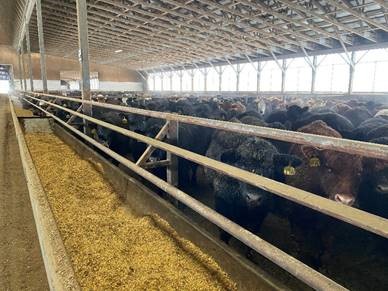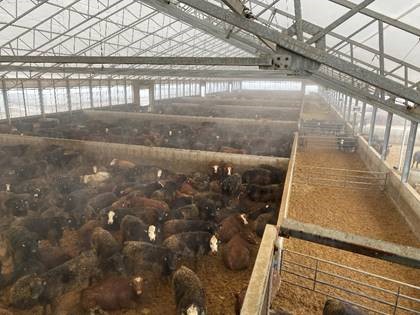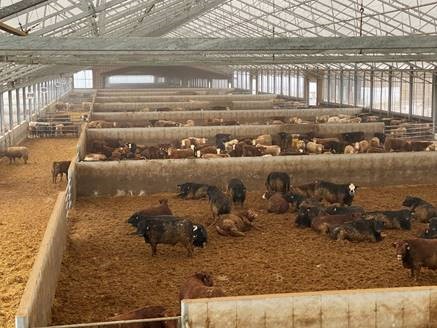Cow-Calf Corner | January 30, 2023
Cattle Feeding in Ontario, Canada
Derrell S. Peel, Oklahoma State University Extension Livestock Marketing Specialist
Recently I had the opportunity to visit Ontario for the Ontario Cattle Feeders Association Annual Beef Industry Convention in London, Ontario. The organization is celebrating its 25th anniversary in 2023.
In addition to a great convention, I had the opportunity to visit a number of cattle feeding operations and learn a bit about how cattle feeding works in this unique environment.
Cattle feeding in Ontario is almost entirely indoors due to the cold and wet climate of the region. The photos show several different cattle feeding operations. Ontario is a significant crop production region and feeders utilize corn (dry and high-moisture) and co-products (mostly wet distiller’s grains) intensively.
Waste management is a major issue with barns using either solid floors, which must be scraped and re-bedded weekly or slatted floors with liquid waste lagoons. In either case, farms must have several months to a year of manure storage as manure can only be applied to cropland in short summer windows of time. Manure is an increasingly valuable output, especially with current fertilizer prices.
The Ontario cattle feeding industry utilizes several sources of cattle. Most of the beef cows in Canada are in the Prairie Provinces and feeder cattle have historically moved east to supply the feedlot industry in Ontario. Cattle are also sourced from Virginia and surrounding regions in the U.S. at times when cattle prices and exchange rates are favorable. Increasingly now, however, the rapidly growing source of cattle are beef x dairy crossbred calves from Ontario and Quebec.
The organization is also celebrating 25 years of the Ontario Corn Fed Beef program, which continues to have success in both domestic and international beef markets. The program has been particularly successful in Japan.
Seeing cattle feeding in this environment emphasizes again to me, the extraordinary ability the beef industry to adapt to a wide range of locations and environments.
I enjoyed tremendous hospitality from cattle feeders in Ontario and I wish continued success for them.
Photos provided by Derrell Peel.
Calf Scours and Calving Pasture Rotation
Mark Z. Johnson, Oklahoma State University Extension Beef Cattle Breeding Specialist
Calf scours results in sickness, poor performance, medical expenses and death. Scours is a complex disease with many inter-related causes. Agent, host and environmental factors collectively explain scours and these factors interact dynamically over the course of time. Infected calves, typically become ill or die from diarrhea by one or two weeks of age. Regardless of what causes the disease, the first seven to 14 days of age defines the age of susceptibility as well as the age calves are most likely to become infected and shed the agents in their manure. This is important because in many (if not most) calving systems the number of potentially infected calves may outnumber the number of susceptible calves resulting in high potential to transfer a disease causing dose of pathogens. Although the cow herd serves as the source of calf scour pathogens from year to year, the average dose load of pathogen exposure to calves is likely to increase over time within a calving season because calves infected earlier serve as pathogen multipliers and become the primary source of exposure to younger susceptible calves.
The management plan defined as the “Sandhills Calving System” works by segregating calves by age to prevent transmission of pathogens from older to younger calves through the scheduled movement of pregnant cows to clean calving pastures which have been unoccupied by cattle for several months.
- Initially, pregnant cows are turned out in the first calving pasture where calving season runs its course for two weeks.
- After two weeks, cows that have not yet calved are moved to a second pasture while the pairs stay in the first calving pasture.
- After a week of calving in pasture two, the remaining bred cows are moved to a third pasture while the calves born in pasture two remain as pairs in pasture two.
- Each subsequent week, the remaining bred cows are moved to a new pasture and the pairs remain in their pasture of birth.
This results in pairs in multiple pastures each containing calves born within a week of each other. Cow-calf pairs from different pastures can be commingled after the youngest calf is four weeks of age at which time all calves are considered low-risk for neonatal diarrhea.
This system may take some ranch specific planning in advance, but when implemented the system continually re-creates the optimum conditions that exist at the beginning of calving season. The system uses clean calving pastures to prevent direct contact between older calves and younger calves. Accordingly, it prevents later born calves from being exposed to an accumulation of pathogens in the environment and results in less sickness, use of medications and death due to calf scours.
References
Basic Principles used in the “Sandhills Calving System” and How They Apply to other Production Environments. David R. Smith. Proceedings, The Range Beef Cow Symposium XX. 2007
Assessing Calf Vigor
Barry Whitworth, DVM, Senior Extension Specialist, OSU Department of Animal and Food Sciences
In human medicine newborn babies undergo an APGAR test following birth. APGAR stands for appearance, pulse, grimace, activity, and respiration. The purpose of the test is to assess how well the baby tolerated the birthing process and how well the baby is doing outside the mother’s womb. An APGAR test for calves similar to the one in human medicine would give cattle producers a clue when to intervene in a newborn’s life. Unfortunately, most attempts to develop such a test for calves have not been successful; however, there are several studies that provide some practical advice on when to intervene with a newborn calf.
In two studies Dr. Homerosky and associates in Canada found two good predictors of calf vigor, calving ease and suckle reflex. Most producers have the ability to assess both components. First, was the calf born in a timely manner and required no assistance. Calves from births that require assistance are more likely to have acidosis. Acidosis is associated with failure of immunoglobulin absorption, sickness, and death in calves. Dr. Homerosky found a correlation between acidosis and the inability of a calf to withdrawal its tongue after being pinched. A producer can check a calf for acidosis by pinching the calf’s tongue. If a calf cannot withdraw their tongue after being pinched, it is likely acidotic and is a good candidate for early colostrum intervention. Colostrum should be consumed in the first four hours following birth.
The second predictor a producers can check for is a strong suckle reflex. To measure the suckle reflex, a producer should insert two fingers in the mouth and rub the roof of the calf’s mouth. A calf should have a strong jaw tone with a rhythmic suckle reflex. A weak suckle reflex indicates the need to feed colostrum.
In another study Dr. Murray found that calves that did not sit up (sternal recumbency) within 15 minutes of birth had reduced absorption of immunoglobulins. Also, calves born to cows that had difficulty birthing took longer to stand. These observations provide clues that the calf will require more care and colostrum intervention to increase the chance of survival.
Most producers are capable of assessing calf vigor based on the above parameters. Any calf born to a cow that has difficulty birthing and/or a calf that has problems with the above tests would be a candidate for early intervention. The best treatment is to give 2 to 3 liters of colostrum from the mother within the first 4 hours of life. Any delay in getting colostrum into the calf will only increase the chance of the calf having problems in life. This does require more work from the producer but should pay off with more pounds of beef at weaning.
If producers would like more information about calf vigor, they should contact their local veterinarian or local Oklahoma State University County Extension Educator.
References
Homerosky ER, Caulkett NA, Timsit E, Pajor EA, Kastelic JP, Windeyer MC. Clinical Indicators of Blood Gas Disturbance, Elevated L-lactate Concentration and other Abnormal Blood Parameters in Newborn Beef Calves. The Veterinary Journal, January 2017 Vol.219: pp.49-57.
Homerosky ER, Timsit E, Pajor EA, Kastelic JP, Windeyer MC. Predictors and impacts of colostrum Consumption by 4H after Birth in Newborn Beef Calves. The Veterinary Journal, October 2017 Vol.218: pp.1-6.
Murray CF, Veira DM, Nadalin AL, Haines DM, Jackson ML, Pearl DL, Leslie KE. The Effect of Dystocia on Physiological and Behavioral Characteristics Related to Vitality and Passive Transfer of Immunoglobulins in Newborn Holstein Calves. Canadian Journal of Veterinary Research, April 2015 Vol.79(2): pp.109-119.




